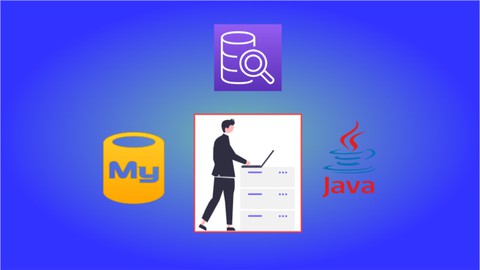
Build Projects using Java JDBC & SQL with practical examples
Build Projects using Java JDBC & SQL with practical examples, available at $54.99, has an average rating of 4.65, with 95 lectures, based on 24 reviews, and has 6036 subscribers.
You will learn about You will learn about Database and Database Server You will learn about Core Java with concepts and code examples You will learn about Tables and Relationship between them You will learn about different types of SQL commands & Joins You will learn about Java JDBC and how to use it in real world You will learn how to establish a connection from Java code to the database and perform different operations like Select, Insert, Update, and Delete. You will also get the complete source code. This course is ideal for individuals who are Anyone who wants to learn about Java Programming and SQL and how to use Java JDBC with SQL to create Projects It is particularly useful for Anyone who wants to learn about Java Programming and SQL and how to use Java JDBC with SQL to create Projects.
Enroll now: Build Projects using Java JDBC & SQL with practical examples
Summary
Title: Build Projects using Java JDBC & SQL with practical examples
Price: $54.99
Average Rating: 4.65
Number of Lectures: 95
Number of Published Lectures: 95
Number of Curriculum Items: 95
Number of Published Curriculum Objects: 95
Original Price: $39.99
Quality Status: approved
Status: Live
What You Will Learn
- You will learn about Database and Database Server
- You will learn about Core Java with concepts and code examples
- You will learn about Tables and Relationship between them
- You will learn about different types of SQL commands & Joins
- You will learn about Java JDBC and how to use it in real world
- You will learn how to establish a connection from Java code to the database and perform different operations like Select, Insert, Update, and Delete.
- You will also get the complete source code.
Who Should Attend
- Anyone who wants to learn about Java Programming and SQL and how to use Java JDBC with SQL to create Projects
Target Audiences
- Anyone who wants to learn about Java Programming and SQL and how to use Java JDBC with SQL to create Projects
In this course, you will learn about JAVA, Databases, Tables, Schema, SQL, and JDBC. You will learn to connect and execute database queries from Java Code.
You will learn how to establish a connection from Java code to the database and perform different operations like Select, Insert, Update, and Delete.
You will also get the complete source code.
Databases are essential tools for storing and organizing large amounts of data, and they have become increasingly important as the amount of data that organizations collect continues to grow. A database is a collection of data that is organized in a way that makes it easy to access, manage, and update. Some common types of databases include relational databases, NoSQL databases, and graph databases.
One of the most popular languages for working with databases is SQL, which stands for Structured Query Language. SQL is a programming language that allows users to manipulate and query data stored in a database. It can be used to create tables, insert data into tables, update data in tables, and retrieve data from tables. SQL is a declarative language, which means that users specify what they want to do with the data, and the database management system (DBMS) figures out how to do it.
JDBC, which stands for Java Database Connectivity, is a Java API for connecting to databases and executing SQL statements. JDBC provides a standard interface for Java programs to interact with databases, making it easier for developers to work with different types of databases. With JDBC, developers can create database connections, execute SQL statements, and retrieve results from queries.
Together, SQL and JDBC are powerful tools for working with databases. SQL allows users to manipulate data stored in a database, while JDBC provides a standardized way for Java programs to connect to and interact with databases. This combination of tools has become a cornerstone of modern data-driven applications, enabling organizations to collect, store, and analyze vast amounts of data to gain insights and make better decisions.
Course Curriculum
Chapter 1: Introduction & Setup
Lecture 1: Course Overview
Lecture 2: About your Instructor
Lecture 3: What is Database and Database Server and Tables
Lecture 4: Real world Explanation of Tables Rows Relationship between Tables
Lecture 5: Different Types of SQL Commands
Lecture 6: Data Types in SQL
Lecture 7: Downloading and Installing the Database Server
Chapter 2: Practicing SQL Queries & Joins
Lecture 1: Creating Category Table
Lecture 2: Create, Alter, Drop and Truncate commands
Lecture 3: DML Insert Data to the Table
Lecture 4: Select Query Examples
Lecture 5: DML Update Query with Example
Lecture 6: DML DELETE Query Example
Lecture 7: Join In SQL with Example
Lecture 8: Types of Join in SQL
Chapter 3: Core Java Mastery: Everything You Need to Know to Start Writing Java Programs
Lecture 1: Introduction and Advantages of Java
Lecture 2: Disadvantages of Java
Lecture 3: Basics of Java Programming Language
Lecture 4: Java Life Cycle
Lecture 5: Downloading and Installing Java
Lecture 6: Writing , Compiling and Running our First Java Program
Lecture 7: Understanding our First Java Program
Lecture 8: Downloading and Installing IDE
Lecture 9: Creating first java project in IDE
Lecture 10: Comments in Java
Lecture 11: Naming Convention Part-1
Lecture 12: Naming Convention Part-2
Lecture 13: Variable and Data Types in Java
Lecture 14: Playing around with data Type Variables and Operators
Lecture 15: Using For Loop in Java
Lecture 16: Using While Loop in Java
Lecture 17: Using do While Loop in Java
Lecture 18: If and If Else in Java
Lecture 19: If ElseIf Else in java
Lecture 20: Taking User Input from Keyboard
Lecture 21: Making Java Program to keep running
Lecture 22: TernaryOperator in Java
Lecture 23: Switch Case and Break in Java
Lecture 24: Understanding Object Oriented Programming
Lecture 25: Understanding OOPS Concept Part-1
Lecture 26: OOPS Concept Analogy
Lecture 27: Understanding OOPS Concepts wit Real World Examples
Lecture 28: Object and Reference vs Heap and Stack
Lecture 29: Working with Object and Classes
Lecture 30: Understanding concept of Polymorphism, Static and Dynamic Polymorphism in Java
Lecture 31: Polymorphism, Method Overloading, Debugging
Lecture 32: What are Constructors
Lecture 33: Constructor Overloading, this keyword
Lecture 34: Understanding concept of Inheritance in Java
Lecture 35: Inheritance, super keyword, Dynamic Polymorphism
Lecture 36: Inner Class and Object of Inner class in Java
Lecture 37: Undertsanding abstract class and abstraction in Java
Lecture 38: Handson examples of Abstraction and Abstract class in Java
Lecture 39: Understanding Arrays in Java
Lecture 40: Handson with Array Examples
Lecture 41: Mini Project with Array
Lecture 42: Concept of Static in Java
Lecture 43: Handson and Debugging for Static concept in Java
Lecture 44: Concept of Final in Java
Lecture 45: Handson with Final keyword in java
Lecture 46: Concept of Interface and Multiple Inheritance in Java
Lecture 47: Handson and Debugging for Interface and Multiple Inheritance in Java
Lecture 48: Concept of Wrapper Class, Autoboxing and Unboxing
Lecture 49: Handson Examples for Wrapper class, Autoboxing and Unboxing
Lecture 50: Concept Of String and its methods in Java
Lecture 51: Handson with String and String Functions
Lecture 52: Handson with StringBuilder and its Functions
Lecture 53: Handson with CompareTo method in String
Lecture 54: Concept of Access Modifiers in Java
Lecture 55: Handson with Accessmodifiers
Lecture 56: Concept of Collection Framework in Java
Lecture 57: Handson with Raw ArrayList with Mixed Datatype elements
Lecture 58: Handson with Generics based ArrayList
Lecture 59: Handson with Custom Class and ArrayList
Lecture 60: Handson with ArrayList methods
Lecture 61: Handson with Set and Hashset in Collection Framework
Lecture 62: Handson with Map and its Uses
Lecture 63: Concept of Exception Handling in Java
Lecture 64: Handson with Arithmetic Exception handling
Lecture 65: Handson with NullPointerException handling
Lecture 66: Handson with ArrayIndexOutOfBoundException handling
Lecture 67: Concept of Finally Block in Exception handling
Lecture 68: Handson with Finally Block in Exception Handling – part-1
Lecture 69: Handson with Finally Block in Exception Handling – part-2
Lecture 70: Handosn with Custom Exception handling
Chapter 4: JDBC in Action: Concepts and Practical Code Examples
Lecture 1: What is JDBC in Java and Why do we need it
Lecture 2: JDBC concept of getting connection and executing queries
Lecture 3: Creating new Java Project and Adding Jar to Intellij
Lecture 4: Creating database Configuration class to create connection
Lecture 5: Adding new User to Database by Taking user Input
Lecture 6: Testing adding of new user
Lecture 7: Get All users and test it
Lecture 8: Update User data and test it
Lecture 9: Delete user based on Username and test it
Chapter 5: Source Code
Lecture 1: Codebase
Instructors
-
Ranjan Pandey
Software Professional with 14+ years of experience in IT
Rating Distribution
- 1 stars: 0 votes
- 2 stars: 0 votes
- 3 stars: 1 votes
- 4 stars: 6 votes
- 5 stars: 17 votes
Frequently Asked Questions
How long do I have access to the course materials?
You can view and review the lecture materials indefinitely, like an on-demand channel.
Can I take my courses with me wherever I go?
Definitely! If you have an internet connection, courses on Udemy are available on any device at any time. If you don’t have an internet connection, some instructors also let their students download course lectures. That’s up to the instructor though, so make sure you get on their good side!
You may also like
- Best Public Speaking Courses to Learn in March 2025
- Best Affiliate Marketing Courses to Learn in March 2025
- Best Email Marketing Courses to Learn in March 2025
- Best Social Media Management Courses to Learn in March 2025
- Best SEO Optimization Courses to Learn in March 2025
- Best Content Creation Courses to Learn in March 2025
- Best Game Development Courses to Learn in March 2025
- Best Software Testing Courses to Learn in March 2025
- Best Big Data Courses to Learn in March 2025
- Best Internet Of Things Courses to Learn in March 2025
- Best Quantum Computing Courses to Learn in March 2025
- Best Cloud Computing Courses to Learn in March 2025
- Best 3d Modeling Courses to Learn in March 2025
- Best Mobile App Development Courses to Learn in March 2025
- Best Graphic Design Courses to Learn in March 2025
- Best Videography Courses to Learn in March 2025
- Best Photography Courses to Learn in March 2025
- Best Language Learning Courses to Learn in March 2025
- Best Product Management Courses to Learn in March 2025
- Best Investing Courses to Learn in March 2025






















